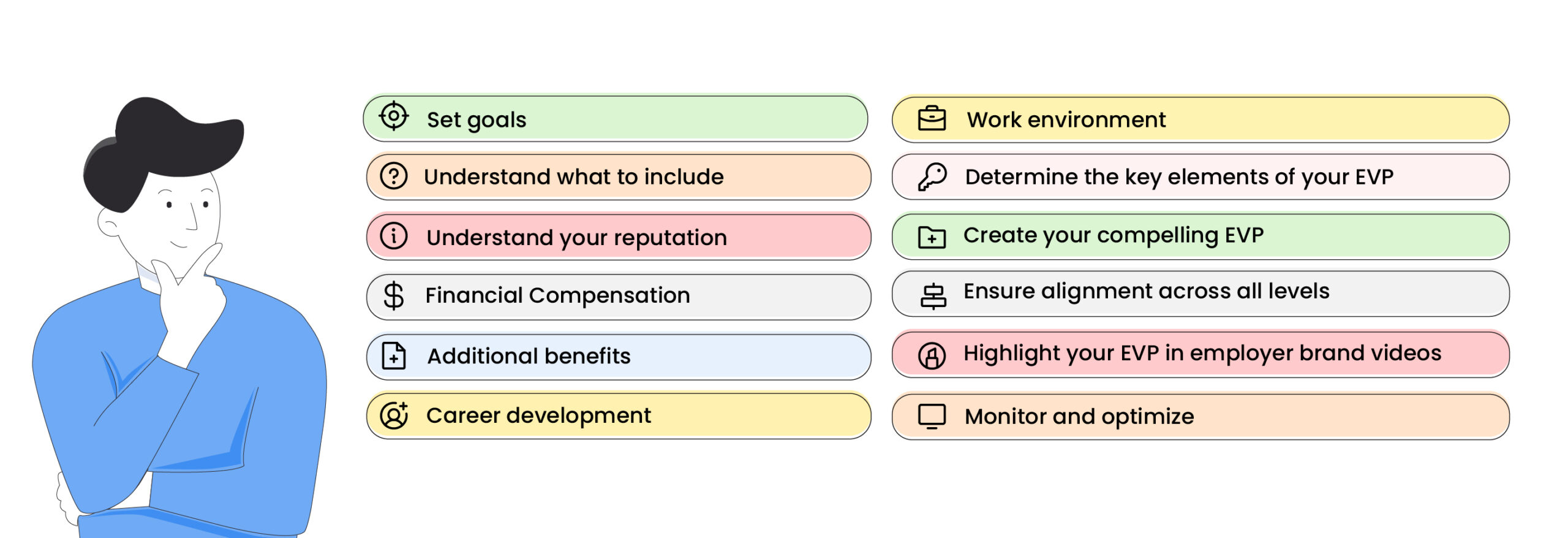As talent acquisition is getting increasingly competitive, recruiters are looking for new and effective ways to attract and retain the finest talent.
Times have changed, and companies need to portray themselves as capable employers to appeal to the best-skilled professionals, similar to how they approach customers.
That’s where creating an employee value proposition can profusely help you.
Travis Lindemoen, the Managing Director of Nexus IT Group, states, “the significance of EVP lies in the fact that it provides a full look into each position, ensuring that the post is appealing to the top talent.”
In this blog, we will discuss what EVP is, its key elements, and how to craft a compelling employee value proposition framework for your company.

What is an employee value proposition?
The Employee Value Proposition (EVP) is a strategic concept used by organizations to define and communicate the unique set of benefits and rewards that they offer to their employees in exchange for their skills, contributions, and commitment to the company. In simpler terms, it is the collection of reasons why employees choose to work for a particular organization and what they gain from being a part of it.
The Employee Value Proposition framework goes beyond just salary and benefits; it encompasses various aspects that make the organization attractive to potential and current employees. It aims to differentiate the company from its competitors in the job market and helps in attracting and retaining top talent.
In simple words, EVP is the set of benefits you offer employees in return for the skills, experience, and qualities they bring to the position.
Examples of an employee value proposition
Creating a great employee value proposition is about examining your organization’s key strengths and what makes it an extraordinary workplace. Let us look at some employee value proposition examples from companies that are doing it the right way:
1. LinkedIn
LinkedIn’s slogan is #LinkedInLife, which sums up its EVP framework and employer brand tone.
It portrays that the company values a shared sense of belonging and focuses on maintaining a welcoming and inclusive environment for all its employees.
The benefits are diverse and include health, family, passion, must-haves, and extras. The company also offers paid shutdown at the end of each year, which is a week off for all workers.
2. Canva
As an online design and publishing tool, Canva’s mission is “empowering people to design anything and publish anywhere,” — which is an appealing aspect of their employee value proposition framework and calls in applicants with similar values.
They also narrate a gripping story of why it is so great to work for them on their ‘Why Canva?’ page.
Further, besides free lunch and breakfast prepared by in-house chefs, they offer free memberships to local fitness studios, clubs, sports, relocation benefits, etc.
3. Made Tech
Another notable employee value proposition is Made Tech, a UK-based digital, data, and technology services provider.
Their career page highlights a catchy header: “Use your skills to transform our society. Join a team with a purpose,” which reflects their mission and vision.
They also include testimonials representing an inclusive, supportive, and welcoming team culture. Moreover, their open source handbook stands to show their commitment to transparency.
Why is employee value proposition important?

Developing a compelling employee value proposition is critical to achieving corporate success. Here are a few instances of how a great EVP may help your organization.
Helps in reducing turnover
Organizations that offer genuine value to their employees are more likely to recruit and retain top talent. According to a recent Gartner analysis, companies that deliver on their EVP may reduce employee turnover by over 70% while increasing recruit commitment by nearly 30%.
Creates a welcoming workplace atmosphere
According to research, diverse businesses beat various competitors in various important indicators, including overall performance, share price, profit, and innovation. An EVP that combines enticing perks with fair and equitable pay and an inclusive work environment increases a company’s chances of recruiting diverse talent.
Utilizes employee advocacy
Employees that are engaged and understand and respect their company’s EVP might be your finest brand advocates. Employee advocacy can be even more effective than traditional marketing efforts. Employee support may significantly influence business performance, from increased social media messaging reach to excellent conversion rates.
What are the five components that stand at the foundation of employee value proposition?

The Employee Value Proposition, also known as EVP, is constructed around five essential pillars that collectively describe what an organization gives to its employees, hence influencing the total employment experience. These pillars are also known as the employee value proposition. Let’s go into further detail about each of these pillars:
1. Financial Reward and Other Benefits:
This pillar comprises the monetary compensation that employees get, such as salary, bonuses, and stock options. Other benefits include health insurance and retirement plans. It also includes benefits that are not monetary in nature, such as health insurance, retirement plans, and any other perks that are offered by the company. The provision of lucrative cash rewards and alluring benefits packages is an essential component in the process of recruiting and retaining top employees.
2. Opportunities for Professional Advancement and Career Growth:
Employees look for ways that they can improve both their personal lives and their careers while working for an organisation. This pillar includes providing training programmes, mentorship, workshops, and a well-defined path for career advancement. When companies engage in the professional development of their staff, they increase the likelihood that they will be able to keep talented employees who have the sense that they are respected and supported in their professional path.
3. Striking a Balance Between Work and Life:
It is becoming increasingly necessary for employees to strike a good balance between their personal lives and their professional lives. This pillar entails the implementation of flexible working arrangements, choices for remote work, and policies that place an emphasis on the well-being of the workforce. A staff that is more engaged and productive can be fostered by an employer that recognises the significance of maintaining a healthy work-life balance.
4. The Culture and Values of the Organisation:
Having a company culture that is upbeat and welcoming to all employees is an important component of EVP. This pillar encompasses the organization’s fundamental goals, guiding principles, and general culture as a whole. An engaging employee value proposition (EVP) is one that resonates with the core beliefs held by the company’s workforce and helps to instill in them a sense of belonging and purpose.
5. Recognition and Other Forms of Reward:
Employees value the opportunity to be acknowledged and rewarded for their efforts to the company. Implementing a number of different recognition programs, opportunities for progression based on merit, and awards tied to performance are all part of this pillar’s responsibilities. The act of publicly acknowledging and applauding the successes of employees can have a substantial impact on both morale and motivation.
Employee value proposition vs. employer brand: Know the difference
The main difference between employee value proposition and employer brand is that the former is an internal element while the latter is external.
The employer brand is how the company appears to the outside world as a potential employer. It includes several factors that affect a person’s perception while considering a company as a prospective employer.
On the other hand, EVP is what the company shows to its employees as an employer portrayal.
Employer brand is the creative and outward expression of a company’s EVP, whereas your EVP is more of a result of thorough preparation actively involving your employees via focus groups, surveys, interviews, etc.
Simply put, your EVP is the ‘why’ of your company, and your employer brand represents the ‘how’ and ‘what.’ However, while EVP and employer brands are not the same, there has to be a smooth alignment between them to build a successful business.
How to Improve Your Organization’s Employee Value Proposition?
In today’s competitive job market, it’s important for companies to improve their Employee Value Proposition (EVP) if they want to draw and keep top talent. An EVP is the unique set of perks and rewards that a company gives its workers in exchange for their skills, experience, and dedication. Here are a few employee value proposition examples to help your business improve its EVP:
Competitive pay:
Offer a salary and benefits plan that is the same as or better than what is typical in the business. Include bonuses, incentives, and chances to earn more money based on success.
Career growth and development:
Give employees clear ways to move up in their careers and invest in programs, coaching, and training to help them grow. Show that you care about your employees’ career growth.
Work-Life balance:
Offer flexible work hours, the chance to work from home, and a lot of paid time off to help people find a good balance between work and life. Show that your company cares about its workers’ well-being.
Employee recognition and rewards:
Set up programs to recognize and reward good performance and accomplishments that go above and beyond. Celebrate workers’ successes in public to boost morale.
Inclusive and diverse workplace:
Create a place of work where everyone feels welcome and valued, and where diversity is honored. Show that you are serious about promoting diversity in leading roles.
Health and wellness benefits:
Give your workers full health insurance coverage, wellness programs, and help with their mental health to show that you care about their overall health.
Meaningful work and a bigger purpose:
Make it clear what the company’s goal and vision are and how employees fit into that. Show how their work has helped society or the neighborhood.
Strong company culture:
Make sure the values of your company are in line with the values of your workers. Provide team-building activities, social events, and other ways to make people feel like they belong.
Transparent communication:
Help everyone in the organization talk to each other in an open and honest way. Inform employees often about company events, changes, and plans for the future.
Employee benefits and perks:
Offer unique perks and benefits that make your business stand out, like on-site child care, gym memberships, pet-friendly policies, or transportation subsidies.
Social and environmental responsibility:
Talk about the company’s efforts to be socially and environmentally responsible, such as by using sustainable practices, starting charitable projects, or giving workers the chance to volunteer.
By constantly improving and highlighting these parts of your organization, you can make a compelling Employee Value Proposition that draws and keeps top talent, leading to a more engaged and productive workforce.
How do you create employee value proposition framework?

EVP can be the core of employer branding if done correctly. You need a framework built on employee feedback and actionable insights to build a compelling EVP. Apart from revealing the essence of the company’s mission and vision, EVP also incorporates many elements, and you do not want to miss them.
Follow the below steps when developing an employee value proposition model to attract the best candidates:
1. Set goals
Before creating your employee value proposition framework, determine what you want to achieve through it.
Be it better employee engagement, filling the pipeline with the most acceptable candidates, retaining them, or encouraging employee advocacy, you should clearly perceive what you are looking to accomplish through an EVP.
2. Understand what to include
Creating a compelling EVP framework depends on how well you understand what you must discuss in detail and where you need to be brief. Let’s start with what are the must-haves in an ideal EVP.
A great employee value proposition should reflect your organization’s unique culture and goals. But it must also incorporate the programs and practices that are most important to today’s employees. However, the practices and benefits you detail should align with what your company does.
For example, if you have a chain of pharmacies, focusing on health benefits and fitness opportunities will appeal to candidates with a genuine interest in the sector. If you run a tech company, offering candidates opportunities to innovate can make your EVP framework very effective.
As transparency is a must in an EVP, ensure that it is an extension of your business strategy and corporate brand and paints a clear picture for the prospects. Your employer value proposition strategy must include a clear narrative describing the organization’s employee recognition plan, career growth and innovation opportunities, employee wellness, benefits, etc.
Your employee value proposition framework needs to be holistic, but going overboard with it will hinder its effectiveness. One EVP describing everything to every candidate will not work. Focus on what job role you want to fill and only include what appeals to that audience. It also must be flexible enough to be validated with changing standards.
The employee value proposition framework should also be less aspirational and more factual. Exaggerated benefits and sugar-coated policies will not work for the long haul. Your company must be capable of backing up what you put in the EVP.
While salary and benefits are essential to incorporate, avoid focusing only on tangible benefits. Try to strike a balance by describing non-financial and cultural advantages, which will help your company to stand out among its competitors.
3. Understand your reputation
The best way to understand your reputation is to talk to your existing employees and ask for their opinions. Ask the important questions, such as:
- How do they feel about working with their coworkers in your company? What is the management like?
- What are their suggestions regarding the management practices in the company?
- What is their perception of senior leadership?
You need to employ surveys to take feedback from them before deciding on an employee value proposition framework. Analyzing the collected data would allow you to understand the existing perception and identify areas needing improvement. You may have to listen to some uncomfortable opinions, but it is the most effective way to gauge your reputation in the workforce.
4. Financial compensation
Salary and benefits are no longer the sole motivators for employee engagement, but they play a big part in crafting an employee value proposition framework. The financial element of EVP deals with every financial benefit of the employees.
Employee surveys help you with it. Try to know how satisfied employees are with their compensation, where your employee salary stands in your industry, whether it is fair, etc.
5. Additional benefits
Additional benefits in EVP show the other perks an organization offers employees besides the salary. These include healthcare, paid leave, work-from-home options, retirement planning, etc. You can provide health insurance, contribute towards retirement savings, offer additional paid leave, and gift coupons as an employer.
According to Peter Beeda, COO of FHA Lend, there is no strict constraint on designing an additional benefits package. So don’t be afraid to get creative with it. Focus on benefits that fit your culture.
You can also ask your existing employees about their preferences. It can give you a better perspective on how to create a one-of-a-kind EVP that shows you care about them and are willing to go the additional mile for them.
6. Career development
Reflecting on your company’s career development programs in your EVP is crucial, even if you are looking to fill entry-level job positions and hire freshers. A person looking for an entry-level job does not intend to run behind growth. They want stability and financial security (think Maslow’s hierarchy of needs).
Give them more than they expect to show your potency as an employer. Offer them learning and development initiatives relevant to their interests and fields. This gives them a chance to learn and progress within your organization. It can include training courses, leadership training, further education, internal mobility programs, job shadowing, etc.
Outline career paths that cover the freshers, the experienced employees, the management, and beyond.
7. Work environment
To attract the best talent, the importance of the work environment is not to be underestimated. Companies must enable a work environment that encourages employees to do their best.
The work environment as a part of your employer value proposition strategy includes work-life balance, company culture, flexibility, etc. Your EVP must detail how your company fosters a healthy work environment.
Mention initiatives that make you unique. It should depict what it is like to work in your office on average. A positive work environment contributes to employee experience, increases employee engagement and satisfaction, and reduces employee attrition rates.
8. Determine the key elements of your EVP
You will need to create many employee value proposition frameworks for different segments of jobs at your company. There will be one for entry-level positions, one for managers, a few for other professionals, etc.
Each EVP will have certain elements essential to its targeted audience. After thorough research, you will better understand each key element and can highlight them in your EVP as necessary.
9. Create your compelling EVP
After thoroughly researching what makes your organization unique from the competition, what different employee experiences you offer, etc., you can begin to design a strong employee value proposition.
Your employee value proposition framework needs to be clear, tailored, and appealing. The language should be easy and must not seem overwhelming.
The EVP framework needs to accommodate both leadership and employees’ expectations. That way, you will attract the finest talent to your organization and ultimately retain them.
10. Ensure alignment across all levels
Once you take care of all the key aspects, ensure a proper alignment across every element. No part should seem out of place or detached from the rest of the EVP, and all elements should have a united tone.
11. Highlight your EVP in employer brand videos
EVP is about creating a candidate experience that resonates with its core audience.
According to statistics, 70% of consumers prefer to learn about a new brand through watching videos over any other medium.
So instead of drafting EVPs, you can incorporate them in the employer brand video. It will give the audience an overview of the organization’s mission and vision, your company’s work culture, and your EVP. This can be done as part of the application process.
12. Monitor and optimize
To keep your employer value proposition strategy relevant, you must calculate evolving requirements and make changes accordingly. After constructing a well-planned EVP, take some time to test it among a small group of people and see if it works.
Share your first draft with your existing employees and ask for their opinions. Apply the feedback you gather from the test group as you work toward a final draft. After making the changes, you can move in to test the EVP with a small group of actual candidates.
Analyzing the feedback from the test run would show you how to optimize the EVP and ensure you can attract and retain the talent you need.
However, that requires you to keep an eye on your KPI to examine how your recruiting and retention efforts are working out. Focus on changes occurring right after implementing the new employee value proposition framework. Be it positive or negative; any significant change can provide insight into the impact of your EVP. Conduct regular research and frequently ask for feedback. That way, you will always have an updated EVP ready for use.
Asking for feedback should be at regular intervals, and the analyzed results should be accurate. There is no better way to collect employee opinions and maintain precision than running frequent pulse surveys and diving deep through sentiment analysis.
Leena AI’s automated employee surveys will ask your employees the right question at regular intervals, ensure maximum participation, and generate accurate reports via its sentiment analysis feature.
Employee value proposition template
While there is no one size fits all approach to creating an employee value proposition, you can use the following set of steps as a framework or template to get started with yours:
- At the top, write your company’s name and the date.
- The next step is to create a roadmap that details your target labor market, talent competitors, and HR and business strategies.
- Your ‘target labor market’ section should mention segment-specific variations. You can try using a chart.
- The talent competitors section should have a chart to examine the potential attributes of your core EVP for competitive differentiation.
- The business strategy section should include your company’s values, mission and vision, strategic business objectives, and business unit objectives.
- The HR strategy section should mention the focal points of your HR department, the challenges they face, and their solution-oriented approach.
Some benefits of an efficient employee value proposition:
The benefits of an Employee Value Proposition (EVP) that is clear and well-communicated are important for employees and the organization. Here are some of the main pros:
Attracting top talent:
An attractive EVP brings in high-quality people whose values and goals are in line with the organization’s. It makes the company stand out as a good place to work in a competitive job market, which makes it more likely to get the best people.
Retaining employees:
A good EVP helps employees feel loyal and committed to the company. When workers feel valued and involved, they are more likely to stay with the company for a long time. This cuts down on turnover and the costs that come with it, like hiring new people.
Increased employee engagement:
Employees are more likely to be engaged if the EVP meets their needs and wants. Engaged workers work harder, come up with new ideas, and care more about the success of the company.
Improved employer brand:
A well-written EVP improves the image of the employer brand, which makes the organization more appealing to people who might want to work there. A good company brand can bring in more qualified applicants and improve the quality of candidates.
Employee satisfaction and well-being:
An EVP that focuses on work-life balance and employee well-being makes for a good place to work. Employees who are happy and healthy tend to be more focused, creative, and willing to work together.
Alignment with organizational goals:
An EVP that is in line with the mission and values of the company encourages workers to work towards common goals. This coordination improves teamwork and helps the organization work as a whole.
Positive organisational culture:
An organization’s culture can be good if it has a strong EVP. When employees believe in the company’s goal and feel like they are important, they are more likely to act and think in a good way.
Cost savings:
A good EVP can lead to lower costs for loss and new hires. Keeping engaged and committed workers who are already working for you is cheaper than always hiring and training new people.
Increased customer satisfaction:
When workers are engaged and happy, they are more likely to give great customer service. This makes customers happier and more loyal.
Innovation and creativity:
A positive EVP creates an atmosphere where employees feel encouraged to share ideas and take risks, which leads to more innovation and creativity within the organization.
Conclusion
According to Alex Mastin, CEO & founder of Home Grounds, “EVP is an excellent way of attracting the best talent to your company. It is a way of clearly communicating the values, principles, and ethos your company has”.
But to have long-lasting and positive results, you must keep your employees engaged, listen to them, and incorporate their needs.
Here accuracy is everything, be it a quantifiable or a qualifiable measure.
To assist you in this endeavor, Leena AI’s innovative HR solutions will provide you with comprehensive, quick, and efficient surveys and present you with best-in-class sentiment analysis of the collected data.
With its advanced system, you will have every data you need to create a compelling EVP and establish a positive employee brand. Moreover, the system goes beyond mere words and understands what your employees mean through their answers, enables constant optimization, and increases the odds of landing the best candidates.
Build EVP Framework with Leena AI
Schedule A demo TodayFrequently Asked Questions
What is an employee value proposition?
The phrase “Employee Value Proposition” (EVP) refers to the one-of-a-kind collection of perks, prizes, and opportunities that an organization provides to its workers in exchange for their expertise, experience, and dedication to the work. It incorporates everything that makes a company a desirable employer, including income, career progression, work environment, company culture, and any other aspects that contribute to the total experience of working for the company for the employee.
What are the 5 pillars of EVP?
The five pillars of EVP are the key elements that comprise the basis of an organization’s value proposition to its employees. They are also known as the employee value proposition (EVP). These pillars consist of the following:
- Financial Reward and Other Benefits
- Professional Advancement and Advancement of Career
- Striking a Balance Between Work and Life.
- The Culture and Values of the Organisation
- Praise and Other Forms of Reward
What does EVP mean in HR?
In the field of human resources, EVP refers to the Employee Value Proposition. It is a strategy approach that places a primary emphasis on defining and expressing the one-of-a-kind advantages and possibilities that an organisation offers to its staff members. The Employee Value Proposition (EVP) is intended to attract, engage, and keep top talent by highlighting the benefits of working for the firm and setting it apart from other employers in the market.
What is the EVP strategy?
The Employee Value Proposition (EVP) approach entails determining and presenting the most compelling parts of the organization to potential employees as well as those who are already employed by the company. It is an all-encompassing strategy that brings HR procedures into line with the mission, culture, and core values of the organization. The goal of the strategy is to develop a good and distinct employee experience, which will ultimately contribute to the success of the organization by attracting top talent, improving employee engagement, and driving organizational success.
What are employee value proposition examples?
Examples of employee value propositions include providing competitive salaries, extensive benefits packages, opportunities for professional development, initiatives to promote work-life balance, a diverse and inclusive work environment, recognition programs, and a robust company culture that places an emphasis on values and purpose.
How to measure employee value proposition?
The Employee Value Proposition (EVP) can be measured by collecting feedback from employees through interviews, focus groups, or surveys. In addition to this, it entails doing an analysis of staff turnover rates, levels of engagement, and the efficacy of efforts made to acquire talent. In addition, companies can utilize external benchmarking to evaluate their enterprise value proposition (EVP) in relation to that of their competitors and monitor their progress in terms of attracting and keeping talent.
What is the employee value proposition framework?
A systematic methodology that assists organizations in effectively defining, developing, and communicating their Employee Value Proposition (EVP), the Employee Value Proposition framework was developed. It typically entails conducting an analysis of the target talent market, determining the essential components of the EVP, aligning it with the brand and culture of the company, and developing strategies to communicate the EVP to potential candidates through various channels such as career websites, social media, and recruitment materials. For the purpose of developing an employer brand that is compelling and consistent across all touchpoints, the framework is absolutely necessary.






